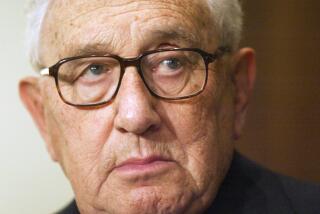Playing Faust to Noriega’s Satan :...
- Share via
In the mind of America, Manuel Antonio Noriega has become the stuff of myth, one of a select few foreign demons (Kadafi and Khomeini are others) who menace the civilized world with boundless evil. Against such demons, any sanction is justified, including last December’s invasion of Panama by the United States Army and Marines--an unprecedented use of American military power to overthrow and capture a single villain.
To be sure, Noriega is a nasty man: a tyrant, a murderer and a drug profiteer (not to mention, as did one U.S. general in Panama, a devotee of voodoo and a wearer of red undershorts). But today, with benefit of hindsight, it is astonishing that President Bush--or anyone else in the U.S. government--could have condemned the crimes of Manuel Antonio Noriega with a completely straight face. For, as these two admirably reported books on Noriega show, the Panamanian dictator was known to U.S. officials as a bad apple for 30 years--three decades during which the same officials consistently elected to ignore the evidence and continue using Noriega as an intelligence source and sometime drug-enforcement ally.
When then-Vice President Bush protested during his 1988 campaign that he was unfairly tagged as Noriega’s friend--that seven administrations, beginning with Eisenhower, had dealt with the man--it turns out he was right. But Bush drew the wrong lesson (or, more precisely, no lesson at all) from his own history. The wonder is not that Noriega hid his evil nature from so many Presidents and CIA directors, but that so many administrations had at least fragmentary evidence of his nastiness and chose not to pursue the matter.
The record, set forth more clearly in these detailed accounts than ever before, is an infuriating cycle of sin and bureaucratic redemption. For 30 years, the wily Panamanian plotter engaged in nearly every variety of corruption, but until 1988, he always made himself just useful enough to the United States to win official absolution.
As early as 1960, according to Frederick Kempe, Noriega’s U.S. intelligence contact learned that his new Panamanian agent had been arrested for raping and beating a prostitute; Noriega stayed on the payroll.
In 1971, both John Dinges and Kempe note, the Nixon Administration’s Bureau of Narcotics and Dangerous Drugs compiled a strong case against Noriega for protecting a marijuana pipeline through Panama. But by then, Noriega was already Panama’s chief of military intelligence, and no conclusive action was taken.
By 1980, the U.S. attorney in Miami was ready to indict Noriega for gunrunning, but the Carter Administration blocked the case--in part because Noriega had been helpful in sheltering the outcast shah of Iran.
In 1984, Noriega directed the Panama Defense Force’s flagrant theft of a presidential election for a candidate owned by the military; a pair of hard-working U.S. diplomats even documented the fraud. But the Reagan Administration favored the military’s candidate, too, and ignored its own evidence.
Not until 1987, when the cumulative outrage of Noriega’s rule drove many normally placid Panamanians into the streets--and, perhaps more important, when the cocaine epidemic suddenly became a potent political issue in the United States--did the Reagan Administration turn against Noriega.
There are two mysterious characters in this story. One is Noriega, the endlessly crafty abandoned child of Panama City’s slums, ugly protege of the charismatic strongman Omar Torrijos, master dealer in information, political manipulator extraordinaire--but, all in all, a trivial figure on the stage of history.
The other, more important character is ourselves. Noriega may have been a devil, but the United States government was the Faust that somehow found itself drawn to bargain with him time and time again. And, in a sense, our deals with Noriega mirror every ugly little trade-off U.S. foreign policy makes in the Third World; most of them simply never go quite this horribly wrong.
The story of Noriega is colorful, exotic and, thanks to Panama’s luxurious profusion of lurid rumors, easy to tell. The story of our own vulnerabilities is more complicated and subtle, harder to get, but surely more important.
Both of these books are built, irresistibly, around the Noriega saga. But Kempe, a correspondent for The Wall Street Journal, seems to have been the one more seduced by the devil Noriega; Dinges, a reporter for National Public Radio, does a better job of focusing on the United States as a confused and inattentive Faust.
Both have unearthed considerable new information. Kempe provides a wealth of detail, especially, on the painful (and abortive) U.S.-Noriega negotiations over the past two years, as well as the unsuccessful anti-Noriega coup of October, 1989.
Dinges has done some admirable investigative work, often using the Freedom of Information Act, as when he reveals a secret State Department report that showed conclusively that Noriega’s men stole Panama’s presidential election.
And he has a provocative new thesis: that Noriega, far from being a drug kingpin, actually disengaged from active complicity in cocaine trafficking beginning in 1984, when he realized that the issue might endanger his relationship with the United States. (The “cocaine” seized from his office refrigerator by U.S. troops last December, for example, turned out to be frozen tamales.)
The final irony, in Dinges’ view, is that the U.S. decision to oust Noriega was as incoherent as the earlier decisions to coddle him. The Reagan Administration allowed two federal prosecutors in Florida to go ahead and indict the general even though some aides warned the action would be a foreign-policy disaster. Why? Because, Dinges argues persuasively, in the aftermath of the Iran-Contra affair--and with drugs becoming a major issue in the 1988 campaign--no one dared to suggest blocking the indictments.
“The use of massive military force in December, 1989, that brought Noriega’s rule to an end was the final proof of the failure of American foreign policy in Panama,” Kempe writes.
But the failure may go one step further. In part because Bush has quite deftly turned his sad experience in Panama into a 24-hour military triumph, it is not at all clear that the lessons of the previous 30 years of failure have been learned.
More to Read
Sign up for Essential California
The most important California stories and recommendations in your inbox every morning.
You may occasionally receive promotional content from the Los Angeles Times.














